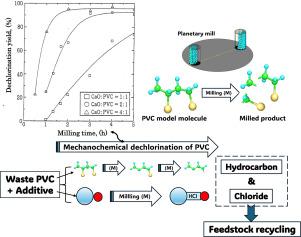Mechanochemical dechlorination of waste PVC resin and feedstock recycling
IF 4.5
2区 工程技术
Q2 ENGINEERING, CHEMICAL
引用次数: 0
Abstract
This article reviewed mechanochemical dechlorination of PVC by milling with additive from our basic research works on experiment and computer-chemistry. The dechlorination yield depends on additive and PVC characteristics as well as grinding conditions. In the dechlorination process, the chlorides and PVC residue have remained in the product, then they can be separated into solid and liquid phases by filtration after water leaching the products. Therefore, the valuable substance from either liquid or solid phases can be recovered by this operation. This leads to a feedstock recycling, and PVC is the source of chlorine for this chloride formation. In the first half of this article, the results on the mechanochemical dechlorination mechanism of PVC is mainly discussed, then, the last half of it dealt with the feedstock recycling using this kind of mechanochemical treatment with PVC for several scrap and wastes which contain valuable substances.

废聚氯乙烯树脂的机械化学脱氯和原料回收利用
本文从实验和计算机化学的基础研究工作出发,综述了通过研磨添加剂对聚氯乙烯进行机械化学脱氯的过程。脱氯率取决于添加剂和 PVC 的特性以及研磨条件。在脱氯过程中,产品中会残留氯化物和聚氯乙烯残渣,经过水浸后的产品可以通过过滤分离成固相和液相。因此,无论是液相还是固相中的有价物质,都可以通过这一操作回收。这就实现了原料的循环利用,而聚氯乙烯正是形成氯化物的氯源。本文前半部分主要讨论了聚氯乙烯机械化学脱氯机理方面的研究成果,后半部分讨论了利用聚氯乙烯的这种机械化学处理方法对几种含有有价物质的废料和废物进行原料回收的问题。
本文章由计算机程序翻译,如有差异,请以英文原文为准。
求助全文
约1分钟内获得全文
求助全文
来源期刊

Powder Technology
工程技术-工程:化工
CiteScore
9.90
自引率
15.40%
发文量
1047
审稿时长
46 days
期刊介绍:
Powder Technology is an International Journal on the Science and Technology of Wet and Dry Particulate Systems. Powder Technology publishes papers on all aspects of the formation of particles and their characterisation and on the study of systems containing particulate solids. No limitation is imposed on the size of the particles, which may range from nanometre scale, as in pigments or aerosols, to that of mined or quarried materials. The following list of topics is not intended to be comprehensive, but rather to indicate typical subjects which fall within the scope of the journal's interests:
Formation and synthesis of particles by precipitation and other methods.
Modification of particles by agglomeration, coating, comminution and attrition.
Characterisation of the size, shape, surface area, pore structure and strength of particles and agglomerates (including the origins and effects of inter particle forces).
Packing, failure, flow and permeability of assemblies of particles.
Particle-particle interactions and suspension rheology.
Handling and processing operations such as slurry flow, fluidization, pneumatic conveying.
Interactions between particles and their environment, including delivery of particulate products to the body.
Applications of particle technology in production of pharmaceuticals, chemicals, foods, pigments, structural, and functional materials and in environmental and energy related matters.
For materials-oriented contributions we are looking for articles revealing the effect of particle/powder characteristics (size, morphology and composition, in that order) on material performance or functionality and, ideally, comparison to any industrial standard.
 求助内容:
求助内容: 应助结果提醒方式:
应助结果提醒方式:


